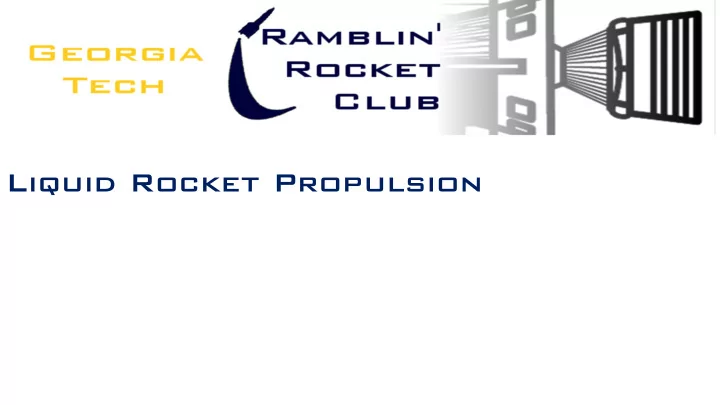

Liquid Rocket Propulsion
Types of Rocket Propulsion • Solid – Fuel and oxidizer coexist in a solid matrix • Liquid – Fluid (liquid or gas) propellants stored separately – Propellants routed to a combustion chamber to react • Hybrid – Combines elements of solid and liquid propulsion – Fluid oxidizer injected into solid fuel grain
Why Liquid Propulsion? • Generally better performance • Control – Ability to throttle – Ability to shutdown (and restart) – Improved thrust vectoring • Safety (isolate and stop failures) • Reusability – Allows for each engine to be tested before use
History of Liquid Propulsion • Liquid propellant engines pioneered by Pedro Paulet in 19 th century • Robert Goddard flies first liquid propellant engine (LOX/gasoline) March 16, 1926 in Auburn, MA • V-2 (LOX/ethanol) developed in the 1930s • Early proponents of liquid propulsion include Tsiolkovsky, Goddard, and Oberth
Engine Cycles • Propellants not burned the same place they are stored (like solids are) • Must have a way to transport propellants from tanks to combustor(s) • Methods of moving propellant vary in cost, complexity, weight, and performance • Many different cycles and variations of cycles, but can be classified in four main categories
Engine Cycles – Pressure Fed • Simplest cycle for rocket propulsion • Relies on a pressurant to force propellant from the tanks to the combustor • Thrust-limited due to the size of the pressurant tank • Shuttle OMS, AJ-10 (Delta II), Kestrel (Falcon 1), Apollo LM Descent engine
Engine Cycles – Expander • Relies on a turbopump to force propellants from tanks to the combustor • Tanks kept at lower pressures • Fuel heated via regenerative cooling process and passed through turbine to drive pumps • Thrust-limited due to square- cube rule (heat transfer) • RL10 (Delta IV, Atlas V), LE-5B (H-IIA, H-IIB)
Engine Cycles – Gas Generator • Relies on a turbopump to force propellants from tanks to the combustor • Tanks kept at lower pressures • Some propellant burned, passed through turbine to drive pumps, and dumped overboard • Most common engine cycle • Merlin (Falcon 9), RS-68 (Delta IV), J-2X (SLS), F-1 (Saturn V)
Engine Cycles – Staged Combustion • Relies on a turbopump to force propellants from tanks to the combustor • Tanks kept at lower pressures • Some propellant burned, passed through turbine to drive pumps, and injected into combustor • Most efficient engine cycle • SSME, NK-33/AJ-26 (N-1, Antares), RD-180 (Atlas V), Raptor (MCT?), BE-4 (Freedom/ Eagle/GalaxyOne)
Turbopumps • Hot gas passes through a turbine to produce power • Power generated by turbine used to drive pump(s) or compressor(s) • Pumps/compressors add pressure to fluid propellants • Turbopumps used to get sufficient mass flow rate to produce thrust
Regenerative Cooling • Common method for cooling rocket engines • Coolant flows over back side of the chamber to convectively cool the rocket engine • Coolant with heat input from cooling the liner is injected into the chamber as a propellant • Fuel is typically the coolant
Film Cooling • Injects a thin film of coolant or propellant at the injector periphery near chamber wall – Typically uses the fuel or a fuel- rich mixture • Typically used in high heat flux regions • Often used in concert with regenerative cooling
Liquid Propellants • Hypergols – Includes hydrazine, MMH, UDMH fuels and NTO, RFNA, WFNA, IRFNA oxidizers – Ignites on contact with each other – Toxic and moderately low-efficiency • LOX/hydrocarbons – Most common class of propellants used (LOX/RP-1) • LOX/LH2 – Most efficient propellants available – Requires large bulky tanks and special materials due to hydrogen environment embrittlement
Physics of Propulsion • Propellant is burned in a combustion chamber, releasing large volumes of hot gases • Combustion exhaust accelerated through converging-diverging nozzle to supersonic speeds • High exit velocity creates large thrust and high efficiency • Conservation of momentum
Nozzle Expansion • Overexpansion – Pressure at nozzle exit less than atmospheric pressure – Plume relatively contracts • Underexpansion – Pressure at nozzle exit greater thanatmospheric pressure – Plume relatively expands • Ideally expanded – Pressure at nozzle exit equal to atmospheric pressure – Plume relatively straight • Static nozzles can only be ideally expanded at one altitude
Injectors • Design crucial to ensure mass flow delivery • Must promote good mixing of propellants for stability • Must sufficiently atomize propellant to promote complete combustion • Baffles, acoustic cavities used to enhance stability
Injectors • Many different designs for injectors, each with different physics • Showerhead • Impinging (like-on-like, unlike, doublets, triplets) • Coaxial • Pintle
Performance Metrics • Thrust – Ideally, T= m v ↓ e or T= m g ↓ 0 I ↓ sp • Specific impulse (Isp) – “MPG” measurement for rocket engines I ↓ sp = T / m g ↓ 0 – Ranges from 275-400 s depending on propellant and cycle • Characteristic velocity (c*) – Measure of the energy available from the combustion process c ↑ ∗ = p ↓ c A ↑ ∗ / m
Common Issues • Reliability – Moving parts, especially turbomachinery – Part count – Extreme environments (hot and cold) • Combustion stability • Decreased density Isp • Cost (especially from development)
Additional Resources • Rocket Propulsion Elements , by G. Sutton • Modern Engineering for Design of Liquid Propellant Rocket Engines , by D. Huzel and D. Huang • Liquid Rocket Thrust Chambers , by V. Yang et al • http://www.braeunig.us/space/propuls.htm
Recommend
More recommend